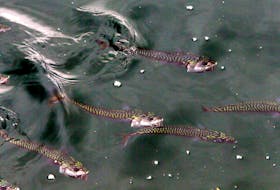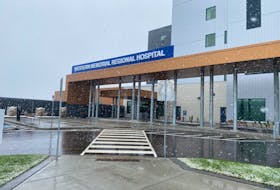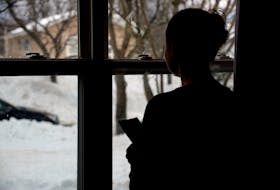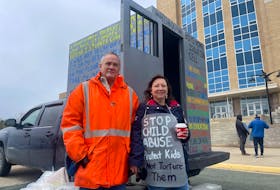STEPHENVILLE The story of the air tragedy known as Crash Hill is taking shape through the archeological team researching the historic site near Stephenville.
On the top of the remote Hare Hill, the pieces of the American Overseas Airlines DC-4 that crashed moments after take off more than 66 years ago still lie in the wilderness of the rugged landscape. The scattered debris is not nearly as tragic as the remains of the 39 dead — nearly half of them women and children, the family of American soldiers stationed in Germany — resting upon the mountain.
The Historic Aviation Committee is attempting to maintain the site, where a hillside graveyard — seldomly maintained because of the challenge to reach the location — and a team has been researching its history and visiting the crash site.
A permit was obtained and artifacts such as a woman’s shoe, a navigational tool and the co-pilots control panel have been collected. They are being preserved in a Memorial University of Newfoundland lab. It is now designated a provincial archeological site, but Lisa Daly wants to see much more done to maintain it and recognize its significance.
Initial recovery
The archeologist and committee member recognized early that collecting documentary information on the crash, the recovery, and the impact of the ordeal would be difficult. Media coverage and crash reports from this time were of little help beyond the basic details. The local people involved had been tight lipped, most traumatized by the gruesome sights and the devastating tasks asked of them.
“Some of them were the first Newfoundlanders out to the site for the initial recovery, and others were out within a couple of days trying to help clean up the site as well as setting up the cemetery at the top of the hill,” Daly said.
However, in the past year people have become more willing to share their memories or stories. Daly said the attention the team has received prompted local people involved in the recovery or their relatives — and family members of the crash victims — has helped give some the strength to talk.
“There are some people who remember the crash itself who will talk willingly, and they want to talk about it and share the story,” she said. “There are others who really don’t want to. For some people, it is still really hard. Thirty nine people died, some of them were infants. It’s not easy. Especially for people who remember dealing with the infants, holding them or seeing them, it’s really difficult still.”
For family members of the Americans who died, it is about putting together a puzzle that has been a mystery for so long. There is still a question for many about what exactly happened, according to Daly.
“There are questions like, ‘what happened to my grandfather’ and ‘why do I not know him,’ that some are looking for answers to,” she said. “He died in a plane crash somewhere in Newfoundland, and that is a pretty far away place for some people. It has left questions.”
Through it all, the full story of Crash Hill is coming together.
Daly and the team will be back at Crash Hill again this weekend — weather permitting. Her last visit was only for a couple of hours, this time she is hoping for a full archeological investigation overnight.
“I will be able to better document everything, and get a better idea of what is exactly there,” she said. “Also, to get up to the cemetery, and document everything there. Maybe that can spark getting it fixed up.”
Garden Hill crash
While it is probably the more intriguing work, Daly is not focusing her effort solely on the Crash Hill site.
She has obtained a copy of the original crash report for the Garden Hill crash of a c-54 American Airlines aircraft in 1944. Two years before the Crash Hill tragedy, 12 of 18 people died in a plane crash during a landing at Harmon Field in Stephenville.
There is now a road through this crash site, and not much left to learn from a visit to the area, said the archeologist. Although it too is now a protected archeological site, all that’s left are things that couldn’t be sold for scrap.
However, Daly is still researching the incident and, like with her report on Crash Hill, will pass that along to Stephenville Historical Society for presentation at the Regional Museum of Art and History.
Because the crash was during the war, there is little information about it, she said. So, she is again relying on local people’s account of the crash to help fill in the gaps.
“Some of the survivors speak about meeting Newfoundlanders who helped them out,” she said. It would be nice to know more about that.”
Daly said the people of the Stephenville area have been a great help, and she is willing to give back to the community as much as she can.
She spoke at the museum Thursday evening, looking to provide a glimpse into her work and she has uncovered thus far.
“I want to know more and, certainly what I find, I will share with everyone,” she said.
Other team members include Don Cormier, Shannon Green, David Hebbard, Mike Deal and Pamela Rideout.
STEPHENVILLE The story of the air tragedy known as Crash Hill is taking shape through the archeological team researching the historic site near Stephenville.
On the top of the remote Hare Hill, the pieces of the American Overseas Airlines DC-4 that crashed moments after take off more than 66 years ago still lie in the wilderness of the rugged landscape. The scattered debris is not nearly as tragic as the remains of the 39 dead — nearly half of them women and children, the family of American soldiers stationed in Germany — resting upon the mountain.
The Historic Aviation Committee is attempting to maintain the site, where a hillside graveyard — seldomly maintained because of the challenge to reach the location — and a team has been researching its history and visiting the crash site.
A permit was obtained and artifacts such as a woman’s shoe, a navigational tool and the co-pilots control panel have been collected. They are being preserved in a Memorial University of Newfoundland lab. It is now designated a provincial archeological site, but Lisa Daly wants to see much more done to maintain it and recognize its significance.
Initial recovery
The archeologist and committee member recognized early that collecting documentary information on the crash, the recovery, and the impact of the ordeal would be difficult. Media coverage and crash reports from this time were of little help beyond the basic details. The local people involved had been tight lipped, most traumatized by the gruesome sights and the devastating tasks asked of them.
“Some of them were the first Newfoundlanders out to the site for the initial recovery, and others were out within a couple of days trying to help clean up the site as well as setting up the cemetery at the top of the hill,” Daly said.
However, in the past year people have become more willing to share their memories or stories. Daly said the attention the team has received prompted local people involved in the recovery or their relatives — and family members of the crash victims — has helped give some the strength to talk.
“There are some people who remember the crash itself who will talk willingly, and they want to talk about it and share the story,” she said. “There are others who really don’t want to. For some people, it is still really hard. Thirty nine people died, some of them were infants. It’s not easy. Especially for people who remember dealing with the infants, holding them or seeing them, it’s really difficult still.”
For family members of the Americans who died, it is about putting together a puzzle that has been a mystery for so long. There is still a question for many about what exactly happened, according to Daly.
“There are questions like, ‘what happened to my grandfather’ and ‘why do I not know him,’ that some are looking for answers to,” she said. “He died in a plane crash somewhere in Newfoundland, and that is a pretty far away place for some people. It has left questions.”
Through it all, the full story of Crash Hill is coming together.
Daly and the team will be back at Crash Hill again this weekend — weather permitting. Her last visit was only for a couple of hours, this time she is hoping for a full archeological investigation overnight.
“I will be able to better document everything, and get a better idea of what is exactly there,” she said. “Also, to get up to the cemetery, and document everything there. Maybe that can spark getting it fixed up.”
Garden Hill crash
While it is probably the more intriguing work, Daly is not focusing her effort solely on the Crash Hill site.
She has obtained a copy of the original crash report for the Garden Hill crash of a c-54 American Airlines aircraft in 1944. Two years before the Crash Hill tragedy, 12 of 18 people died in a plane crash during a landing at Harmon Field in Stephenville.
There is now a road through this crash site, and not much left to learn from a visit to the area, said the archeologist. Although it too is now a protected archeological site, all that’s left are things that couldn’t be sold for scrap.
However, Daly is still researching the incident and, like with her report on Crash Hill, will pass that along to Stephenville Historical Society for presentation at the Regional Museum of Art and History.
Because the crash was during the war, there is little information about it, she said. So, she is again relying on local people’s account of the crash to help fill in the gaps.
“Some of the survivors speak about meeting Newfoundlanders who helped them out,” she said. It would be nice to know more about that.”
Daly said the people of the Stephenville area have been a great help, and she is willing to give back to the community as much as she can.
She spoke at the museum Thursday evening, looking to provide a glimpse into her work and she has uncovered thus far.
“I want to know more and, certainly what I find, I will share with everyone,” she said.
Other team members include Don Cormier, Shannon Green, David Hebbard, Mike Deal and Pamela Rideout.








